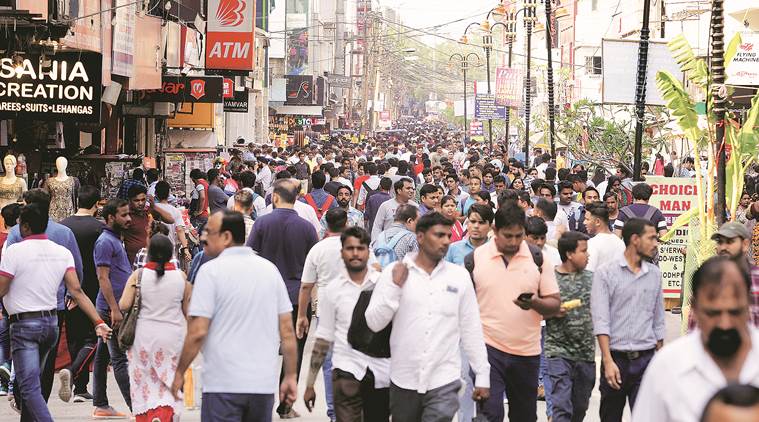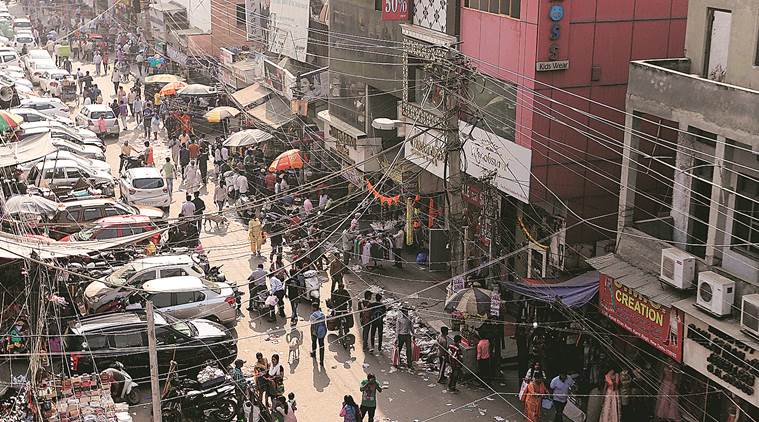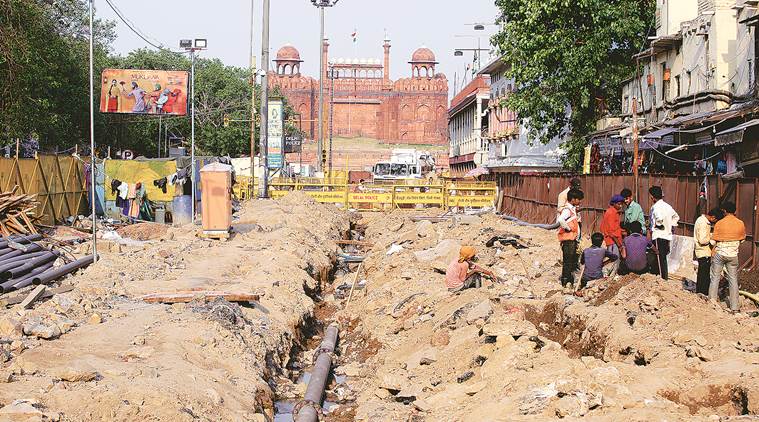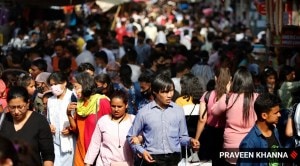- India
- International
Delhi: What it takes to make a road pedestrian friendly
Between March and May, Karol Bagh’s Ajmal Khan Road became ground zero for a project that hopes to put pedestrians first. The Indian Express looks at what it took to make the stretch vehicle-free, and whether similar plans will work in Chandni Chowk and Connaught Place.
 Karol Bagh’s Ajmal Khan Road is now a vehicle-free stretch
Karol Bagh’s Ajmal Khan Road is now a vehicle-free stretch
On a pleasant May evening, arms laden with shopping bags, Payal (22) and her mother sat down on a bench in the middle of Ajmal Khan Road. “The best part about the changes in this market is the new seating. We can sit, rest and shop some more. This has always been my favourite market in Delhi, but there was too much hustle-bustle earlier,” she said.
The “changes” Payal referred to are part of a recent facelift given to Karol Bagh’s renowned Ajmal Khan Road, known for its array of stores offering wedding apparel, prominent retail brands, local brands as well as street shopping choices.
Nine years after a proposal for pedestrianising the area was approved by the Unified Traffic and Transportation Infrastructure (Planning and Engineering) Centre, a 500-metre stretch between Karol Bagh Metro station and Arya Samaj Road cut was declared a vehicle-free zone by the North Corporation earlier this month.
It looks unlike most Delhi marketplaces now. The vehicle-free stretch is punctuated at three crossings, where vehicles run perpendicular to it. Apart from that, shoppers and pedestrians stroll down a street meant only for them — tiled in most parts and dotted with young trees and street lamps. Benches are placed at regular intervals.
“The first thing we have to do now is part two of the Ajmal Khan Road project, extending to DD Gupta Road. There are three things we’re doing together. We have pedestrianised one portion, but before that we identified alternative parking sites and handed those over to the market association. The problem of parking is solved.
Secondly, to encourage people to use them, we have doubled rates of on-street parking and enforcing parallel parking so there is more road space for people to walk. Thirdly, crossroads need to be made one-way for which public consultation will have to be done,” said North body commissioner Varsha Joshi.

Work on the first phase was carried out between March and May this year. Joshi attributed a large part of the smooth roll-out to support from the local market association, which has even set up a valet service to pick up cars from crossings and drop them off at designated parking lots — at Shastri Park, Ajmal Khan Park, Bank Street and Dev Nagar.
The association has its own ideas of how these changes might benefit them. “The idea is to increase footfall at our stores by making this space more attractive and transforming it into an ‘open mall’ — open spaces can also accommodate cultural and food programmes. For this, though, hawkers will have to go. They block pathways and sell similar things at lower rates without paying taxes. There needs to be a designated flea market, which will cater to their customer base, which is not what we are looking for here,” said Sanjeev Kapur, general secretary of the Beopar Mandal Ajmal Khan Road.
Sixty spaces have been demarcated for hawkers at the beginning of the road by the Metro station. Joshi herself is wary of the conversation on “removing” hawkers. “It’s a question of their livelihood and they have to be dealt with cautiously and without heavy-handedness,” she said.
This Central Delhi marketplace is the first sizeable stretch in the city to have been pedestrianised. With the DDA drafting a policy for enhancing walkability in the city earlier this year, the conversation around this subject appears to be gaining momentum. The draft policy acknowledges that Delhi has, by and large, experienced automobile-centric planning despite high volumes of pedestrian movement.
 Ajmal Khan Road before the project. Tashi Tobgyal
Ajmal Khan Road before the project. Tashi Tobgyal
According to P K Sarkar, professor of transport planning at the School of Planning and Architecture, the largest roadblock to pedestrianisation is a lack of political will. On the ground, more immediate obstacles for enforcing agencies are traffic management and a transit plan. “There has to be a way for people to reach the pedestrianised area and get off on foot. Developing Metro and bus connectivity is crucial, we must ensure maximum people come to the area through these. A parking facility needs to be arranged, but its use must not be encouraged. High parking rates in the facility can discourage car usage,” he said.
In its pedestrianisation push, bottlenecks identified by DDA’s draft policy include unregulated hawking and encroachment by homeowners and businesses; weak enforcement of traffic rules concerning pedestrian space; and inadequate pedestrian infrastructure — the DDA found that 40% of road length has no footpaths.
Stressing on the need for holistic pedestrianisation, Sarkar said, “We also have to make sure roads are not just accessible to ‘normal’ pedestrians. Audible traffic signals, tactile markings and wheelchair accessibility are a must. We also need non-motorised options like bicycles or battery rickshaws for those unable to navigate on foot.”
While traffic police have been closely associated with the rollout of the Karol Bagh project, all enforcers agree that this is just the beginning. Several steps, like street signages, additional toilets and lanes for battery rickshaws, are yet to be implemented.
And while this project is gradually standing up on its feet, others are yet to take off. For instance, while the Chandni Chowk redevelopment project has met with some unique challenges, pedestrianisation of Connaught Place has not proceeded beyond preliminary conversations over the years.
Chandni Chowk
 A similar initiative has hit roadblocks in Chandni Chowk
A similar initiative has hit roadblocks in Chandni Chowk
On Friday afternoon, shoppers seemed unbothered by large barricades put up on either side of Chandni Chowk road, which is being turned into a non-motor vehicle zone from Red Fort to Fatehpuri Masjid. Construction on the stretch began in December.
The redevelopment project, being steered by the Shahjahanabad Redevelopment Corporation (SRDC), is working to redesign the road to make it a pedestrian and non-motor vehicle zone between 9 am to 9 pm. The target to complete the project, as per SRDC officials, is March 2020.
The local trade association said the motive has been to decongest the area and reduce pollution. Sanjay Bhargava (62), president of the Chandni Chowk Vyapar Mandal, said, “There used to be traffic hold-ups of over one-and-a-half hours on the road every day, and the area was highly polluted… We need better infrastructure; we have to change with the times.”
However, the project has “slowed down” after conservationists approached the Delhi High Court against some proposals in the plan. Advocate Anish Dayal, representing the complainants, said they objected to utilities — including washrooms, police posts and electricity transformers — being installed along the centre of the stretch. “Installing utilities on the central verge would destroy the heritage of Chandni Chowk. Even the Delhi Urban Arts Commission has rejected this proposal. We made several suggestions (to SRDC), like refurbishing existing washrooms and placing transformers and police posts on the side of the road, but they said they had tried all angles before deciding this plan,” Dayal claimed.
In April, the HC had directed that a meeting of all stakeholders should be convened by L-G Anil Baijal to consider suggestions for the redevelopment proposal. The matter will be presented in court on May 27.
Back at the market, most stakeholders appear optimistic about the project. While shop owners admit there has been a slump in business since construction began, they believe pedestrianisation would benefit in the future. Sudhanshu Jain (34), who runs a clothes shop in the market, said, “Our sales have been affected by over 50%. The idea of a car-free zone makes sense at heritage sites, but Chandni Chowk is a wholesale market… although the hope is that footfall will increase substantially in the long run.”
Mohd Arif (31), who works in a footwear shop, said more customers will be drawn to the market once the chaos and noise reduce. Shoppers Ravinder (58) and Suman Pahuja (55) agree — both said that stopping entry of motor vehicles would encourage them, and others, to visit the market, especially given its proximity to the Metro station.
Anumita Roychowdhury, executive director of research and policy at the Centre for Science and Environment, said pedestrianisation of markets would help reduce carbon emissions in various pockets: “When we reduce intensity of motorised travel, toxic exposure is brought down and this would benefit people walking or shopping in markets.”
Connaught Place
 NDMC chairman Naresh Kumar said the pedestrianisation project ran into stiff opposition from traders.
NDMC chairman Naresh Kumar said the pedestrianisation project ran into stiff opposition from traders.
Over two years after the plan to pedestrianise the Connaught Place Inner Circle was decided by the Ministry of Urban Development, officials of the New Delhi Municipal Council (NDMC) said they are still deliberating on how to implement it.
In January 2017, the then Urban Development Minister Venkaiah Naidu had held a meeting to discuss the plan, saying that a project would be implemented on a pilot basis to assess it. The project was initially scheduled to be implemented in February that year, but faced a delay.
NDMC chairman Naresh Kumar said the pedestrianisation project ran into stiff opposition from traders.
D Chunarkar, administrative secretary of the New Delhi Traders’ Association, explained, “Our business will shut if the Inner Circle is made pedestrian-only. Our customers are mainly people who travel by cars. They park in front of the store, then go and shop. People who come to the market via Metro don’t necessarily come to buy things.”
Chunarkar claimed there ould be “huge traffic jams” spreading from the Outer Circle into Janpath, Barakhamba Road and nearby areas if the Inner Circle was made car-free. He also claimed they had witnessed such jams around International Yoga Day last year, during which the Inner Circle was closed for vehicular traffic.
Kumar, however, said the NDMC is planning to implement the project by the end of June or early July as a three-month pilot, after a consensus is reached among stakeholders. He also said last-mile connectivity is not a problem and they have started a bike-sharing initiative in NDMC areas. While Kumar opposed the idea of using rickshaws to ferry customers, he added, “It could be an e-vehicle… There are many alternatives, including e-scooters, electric golf cart-type vehicles or small, AC buses.”
North Delhi’s Kamla Nagar and West Delhi’s Kirti Nagar markets may be next on the list.
Kamla Nagar
Many shop owners in Kamla Nagar claimed there is traffic congestion nearly every day because of limited parking space for customers and traders.
North MCD commissioner Varsha Joshi said traffic streamlining can be enforced in the area as it already has a multi-level parking facility: “But people still park in no-parking areas. It is a reasonably well-planned area but the problem is of enforcement. Once the market association is with us on it, it is only a matter of implementation.”
She said a team of students from Amity University and a professor from the School of Planning and Architecture have been brought on-board for street-scaping. Joshi said thefocus will primarily be on streamlining traffic: “In the course of work, certain stretches might prove themselves to be suitable for pedestrianisation.”
Shopkeepers, however, said the parking facility is not sufficient. “There are hundreds of shops in each lane and the only parking space is in a mall at the centre of the market… If the market is pedestrianised, there will be more space for people to move around and that will increase our business,” said Harish Gulati, who runs a retail clothing store.
Kirti Nagar
Commissioner Joshi said the Kirti Nagar proposal is currently on the backburner because of ongoing work on the Karol Bagh project. “The team which will work on Kirti Nagar is the one working on Karol Bagh as well. So, we will move on to that once the Karol Bagh project is finished,” she said.
The lanes in Kirti Nagar’s famous furniture market are not as chaotic as those in Karol Bagh or Kamla Nagar. But several store-owners raised the issue of insufficient parking. “The problem is that there is just one small parking area in the market. Only store-owners who reach early can park there. The rest park in front of their stores; so do the other employees. When there is a rush during the weekend, we see double parking, with customers driving around the market looking for parking. It’s hard for customers to move around; plus, cars block the visibility of wares in stores from the street,” said store owner Tony Sharma.
Apr 19: Latest News
- 01
- 02
- 03
- 04
- 05






































